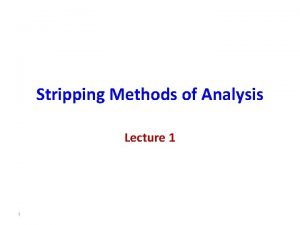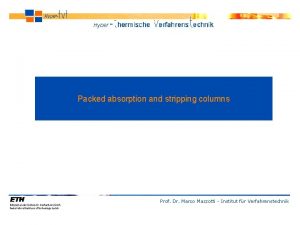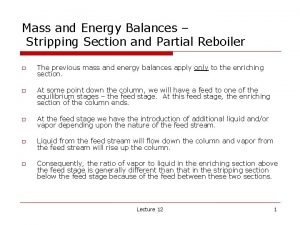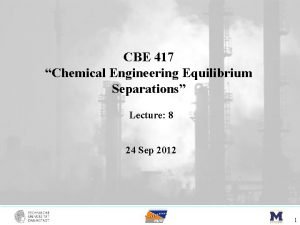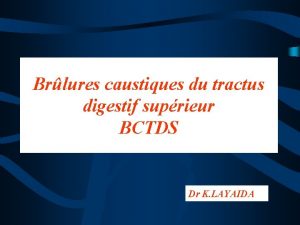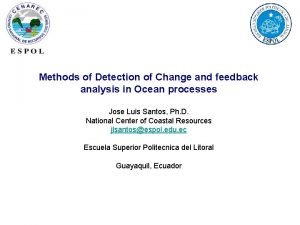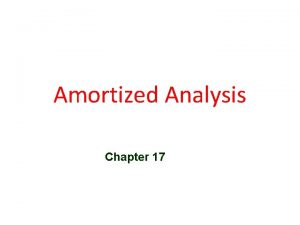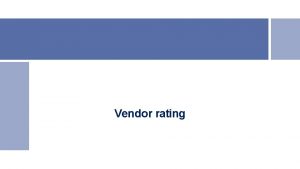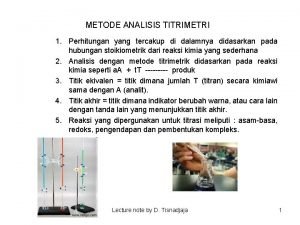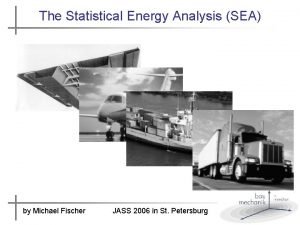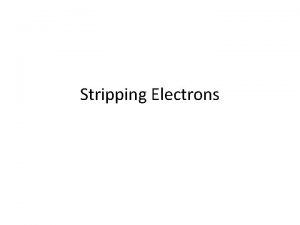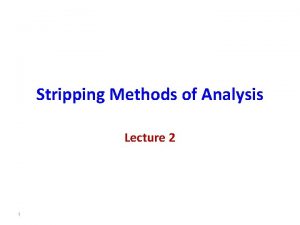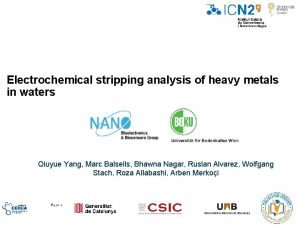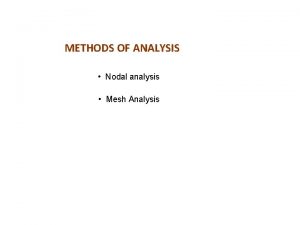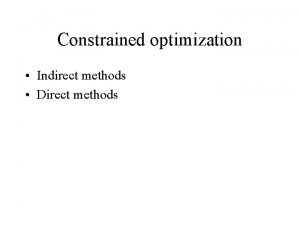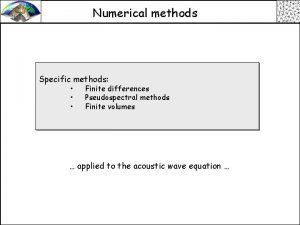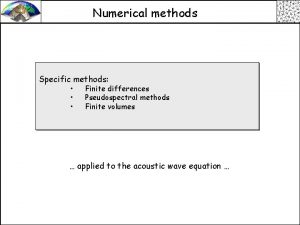Stripping Methods of Analysis Lecture 1 1 Stripping










































- Slides: 42

Stripping Methods of Analysis Lecture 1 1

Stripping Methods Stripping voltammetry methods are the most efficient electrochemical techniques for trace analysis. The unusually high sensitivity and selectivity are based on the fact that the analyte is accumulated before it is determined and that both accumulation and determination are electrochemical processes for which progress can be controlled. In comparison to conventional polarographic work, determinations by stripping voltammetry are generally more sensitive by a factor of 103 to 105, so that the detection limits are between 10 -9 to 10 -11 mol/L and in some cases even 10 -12 mol/L. 2

The term stripping stands for the fact that, during the determination, the accumulated analyte is removed from the working electrode. This process can be followed voltammetrically, potentiometrically, or chronopotentiometrically, this is expressed by the terms stripping voltammetry, stripping potentiometry, and stripping chronopotentiometry. Accumulation always takes place at constant potential (E acc, accumulation potential) at a stationary mercury drop, mercury film, graphite or noble metal electrode for a controlled period (tacc, accumulation time). The analyte is deposited electrolytically as a metal, as a sparingly soluble mercury compound or adsorptively as a complex compound. 3

The accumulated analyte species is removed (stripped) from the working electrode – the real determination step – by an oxidation or a reduction process. In order to differentiate the stripping voltammetric method in which the determination takes place by oxidation of the accumulated product, the term anodic stripping voltammetry (ASV) is used. In the other case where the determination step occurs by reduction of the accumulated analyte species, the method is known as cathodic stripping voltammetry (CSV). With adsorptive accumulation of the analyte the method is known as adsorptive stripping voltammetry (Ad. SV). 4

Electrode configuration 5

6

7

Anodic Stripping Voltammetry Anodic stripping voltammetry (ASV) can be used to determine all metals which are soluble in mercury with the formation of amalgams or which can be deposited electrolytically at carbon or noble metal electrodes. The mechanism for anoding stripping voltammetry can be described using the equation: 8

Eacc = Accumulation potential; ∆E/∆t Potential scan rate; EP Peak potential; i. P Current peak; a: Accumulation time; b: Rest period; c: Determination step; d: Anodic dissolution of the mercury electrode 9

The upper part of the figure is the accumulation time, in which the analyte is deposited onto the working electrode at a constant potential and with the sample solution being stirred continuously throughout accumulation. As deposition is always incomplete, the working conditions must be strictly controlled if reproducible measurements are to be achieved. These include the accumulation time, accumulation potential, the shape, size and arrangement of the stirrer, the stirring speed (rotation), the sample volume and the surface area of the electrode (surface of the mercury drop or film). 10

11

In the lower part of the figure, section b is the rest period. During this period the sample solution is no longer stirred, this means that the cathodic current drops because of lack of convection. As small amounts of the analyte are deposited even from an unstirred solution, this period must also be controlled. Several seconds pass before the solution comes to a standstill and the deposited metal is well distributed in the mercury drop. This is why the rest period is defined as being 5 s to a maximum of 30 s. 12

13

In a mercury film the distribution process is complete after only a few seconds. Section c is defined by the potential scan rate (∆E/∆t = const. ), which is the rate at which the anodic stripping voltammogram is recorded. The measured signal is the peak current i. P, which, in Section d, changes into the anodic current for the dissolution of the mercury electrode. The preconcentration is done by cathodic deposition at a controlled time and potential. The deposition potential is usually 0. 2– 0. 4 V more negative than E° of the metal having the lowest E° (for the metal ion to be determined). 14

15

Amount of accumulated metal in the amalgam The following equation is used to calculate the amount of metal deposited: CM(Hg): Concentration of the metal (accumulated analyte) in the amalgam iacc: Electrolysis current during accumulation tacc : Accumulation time n : Electrons transferred during reduction of the analyte F : Faraday constant VHg : Volume of the hanging mercury drop 16

In case the anodic stripping analysis is done using a hanging mercury drop, then the volume of the drop is given by: While if a thin film mercury electrode (TFME) is used, the volume of the mercury film is given by the relation: VHg = Area of film * thickness of film The electrolysis current, iacc , is determined by the mass transport of the analyte and the potential at which accumulation takes place. To achieve high accumulation rates the solution should be stirred and the accumulation potential should be in the diffusion current range. 17

The transport of the analyte to the electrode surface takes place by diffusion and is supported by convection if the solution is stirred during accumulation (which is usually the case). This means that the electrolysis current, iacc , not only depends on the diffusion conditions, but also on the hydrodynamic conditions which are based on laminar or turbulent flow (at high stirring speeds or when working with a rotating electrode). At a constant stirring speed or number of revolutions, the amount of metal deposited at the cathode is proportional to both the accumulation time and the analyte concentration in the sample solution. M(Hg) a tacc* [Mn+] 18

The accumulation time depends on the concentration of the analyte in the sample solution and must be chosen in a way that the measured signal remains linear throughout as large a concentration range as possible. Deposition is never fully complete at voltammetric working electrodes. Complete deposition may be achieved with very small sample volumes (< 0. 1 m. L) and long electrolysis times, which is in fact not necessary for ASV. Under normal working conditions with 5 to 20 m. L sample solution and about 1 min accumulation time at a mercury drop with a surface area of a few mm 2 only a few tenths of a percent are deposited. 19

ASV Using a HMDE For ASV using a hanging mercury drop electrode, the determination is based on the anodic dissolution of the accumulated analyte, and the process produces a peak current which is proportional to the potential scan rate and the radius of the mercury drop, r 2. i. P , Peak current , n : Electron transfer during oxidation of the analyte DM(Hg) : Diffusion coefficient of the metal deposited in the amalgam CM(Hg) : Concentration of the metal (accumulated analyte) in the amalgam , ν : Scan rate , r : Radius of mercury drop, and tacc is the accumulation time 20

ASV using a thin film mercury electrode (TFME) The following equation applies for the peak current obtained with the TMFE; it can be seen that the peak current is proportional to the scan rate and surface area AF of the mercury film, in addition to accumulation time. i. P Peak current, k Constant, n Electron transfer during the oxidation of the analyte, AF Surface area of mercury film, ν Scan rate, tacc Accumulation time CM(Hg) Concentration of metal (accumulated analyte) in the amalgam 21

22

Measurements with mercury film electrodes produce higher signal currents and narrower peak shapes, but also have relatively high background currents. Good results (with lower background currents) can be achieved with the hanging mercury drop electrode, if the voltammogram is recorded at a slow scan rate and with very small drops. The advantage of a small mercury drop is (similar to the film) the relatively small diffusion area, from which (during anodic dissolution) the analyte can diffuse very rapidly to the surface for exchange. As the mercury drop is easy to handle and can be renewed reproducibly by dropping (tapping), the hanging mercury drop electrode is used more frequently in practice than the mercury film electrode. 23

Stripping voltammograms for 2 * 10− 7 M Cu 2+ , Pb 2+ , In 3+ , and Cd 2+ at the mercury film (A) and hanging mercury drop (B) electrodes 24

Improvement of the Selectivity of ASV The potential-controlled recording of stripping voltammograms has the advantage that the dissolution process can be halted at a particular potential. In this way it is possible to dissolve those metals which are easier to oxidize than the analyte and whose high concentration in the amalgam interferes with the determination of the analyte. After the interruption the recording of the current-potential curve for the unimpeded determination of the (nobler) analyte is continued. Otherwise the relatively small peak of the trace element would be concealed by the signal from the excess components. 25

26

A further way of improving the selectivity of ASV determinations is based on the alteration of the electrochemical behavior of the analyte by complex formation. In many cases selected chelating agents can be used for the better separation of neighboring peaks and to suppress the signals from interfering components. If two elements that are electrochemically similar have to be determined in the sample then a solution of a chelating agent is added that only forms a stable complex with one of the sample components. Both elements are accumulated together at a sufficiently negative potential, however they give separate peaks in the stripping voltammogram. 27

Quantitative Analysis 28

Anodic Stripping Voltammetric Techniques The previously studied voltammetric techniques can be used for stripping of analyte species. These include (but not limited to) the following: 1. Linear scan voltammetry 2. Differential scan voltammetry 3. Square wave voltammetry 29

Linear Scan Anodic Stripping Voltammetry 30

Differential Pulse Anodic Stripping Voltammetry 31

Direct Determination of Zinc, Cadmium, Lead, Copper Metal in Tap Water of Delhi (India) by Anodic Stripping Voltammetry Technique A Case Study J. Raj, et al E 3 S Web of Conferences, 2013 Points to learn and criticize? ? ? 32

Salts of Zinc, Cadmium, Lead and Copper are taken incidentally or accidently and has become of great toxicological importance having toxic effect. In the present study direct determination of Zn, Cd, Pb and Cu metal was carried out from tap water of Delhi (India) using differential pulse anodic stripping Voltammetry(DPASV) at Hanging mercury dropping electrode (HMDE). Determination of Zn, Cd, Pb, Cu was done using Ammonium acetate buffer (p. H 4. 6) (!!!) with a sweep rate (scan rate) of 59. 5 m. V/s and pulse amplitude 50 m. V by HMDE by standard addition method. The solution was stirred during preelectrolysis at -1150 m. V (vs. Ag/Ag. Cl) for 90 seconds and the potential was scanned from -1150 V to +100 V (vs. . Ag/Ag. Cl). 33

levels of several metals such as Pb, Cu, Cd and Zn using ASV DPASV can detect levels in the range of part-permillion (ppm) or even part-per-billion (ppb) (i. e. , ~10 -10 M). Several other methods are also used routinely in addition to DPASV, such as Atomic absorption Spectrometry (AAS) and X-ray fluorescence spectrometry, Inductive coupled plasma, but advantages of using DPASV are that it is a successful, new, rapid, simple, selective and inexpensive for qualitative and quantitative determinations of heavy metals (!!!). 34

The other reasons for using DPASV technique are: It has extremely low detection limits, it works in the presence high salt concentrations, it allows metal speciation and can differentiate between free and complexed metal ions, and it can also analyze non-metals such as anions (!!!) or organics. In this study, DPASV technique was used to determine four heavy metals i. e. , Zn, Cu, Cd, Pb in tap water samples of Delhi (India) using Hanging mercury dropping electrode(HMDE) as a working electrode. 35

Instrumentation/accessories and Operating Conditions Voltammetric determination of Zn, Cd, Pb and Cu was performed with Trace Metal Analyzer (797 VA Computrace, Metrohm AG Ltd, Switzerland) with three electrode system consisting of Hanging mercury drop electrode(HMDE) as working electrode, Platinum (Pt) as auxiliary electrode and Ag/Ag. Cl/ KCl (3 mol/L) as reference electrode. 36

37

Preparation of Supporting Electrolyte (Ammonium acetate buffer) 55. 5 ml of Suprapure acetic acid was taken in a 500 ml volumetric flask. To this about 100 ml of water was added. 37 ml of Suprapure ammonia was added slowly to the volumetric flask. Ammonia had to be added slowly, because heat will be generated while addition. After the addition the solution was diluted to 500 ml with ultra pure water. The p. H of the buffer should be 4. 6. (is ammonium acetate a buffer? ? , also, are stoichiometric concentrations used for preparation? ? ) 38

Anodic Stripping Voltammetric measurements 10 ml ultra pure water and 1 ml of acetate buffer (p. H 4. 6) was taken in polarographic vessel and then the measurement was started, after this voltammogram of the blank was recorded, 1 ml of water sample was added to polarographic vessel and then voltammogram of the sample solution was recorded under the same conditions. After the sample voltammogram was recorded, 0. 1 ml of 1 mg L-1 mixed standard (of Zn, Cu, and Cd. Pb) was added twice and then voltammogram of the standard was recorded. 39

Voltommograms obtanined for samples as well as for standards. Condition: scan rate, 59. 5 mv/s; Pulse amplitude, 50 m. V; Deposition potential, -1150 m. V vs Ag/Ag. Cl; deposition time , 90 s, equilibration time, 10 s; Sacnning range, -1150 to +100 m. V 40

Cathodic Stripping Voltammetry (CSV) -Mirror image of ASV -- Involves anodic deposition of anionic analyte and subsequent stripping by a potential scan in the negative direction An- + Hg ↔ A(Hg) + ne(Deposition to the right and stripping to the left) - Useful for measuring organic and inorganic anionic compounds that form insoluble salts with Hg (thiols, penicillin, halides, cyanides) 41

Square Wave Cathodic stripping Voltammetry 42
 Stripping methods
Stripping methods 01:640:244 lecture notes - lecture 15: plat, idah, farad
01:640:244 lecture notes - lecture 15: plat, idah, farad Slide todoc.com
Slide todoc.com Metal coping fpd
Metal coping fpd Hog nog absorption
Hog nog absorption Stripping section operating line
Stripping section operating line Stripping rectifying section
Stripping rectifying section Town of brookhaven foil
Town of brookhaven foil Stripping rectifying section
Stripping rectifying section Stripping rectifying section
Stripping rectifying section Reelsloader
Reelsloader Stripping rectifying section
Stripping rectifying section Olivette produit caustique
Olivette produit caustique üst ekstremite yüzeyel venleri
üst ekstremite yüzeyel venleri Stripping de l oesophage
Stripping de l oesophage Algoritmo de porter
Algoritmo de porter Exploratory data analysis lecture notes
Exploratory data analysis lecture notes Sensitivity analysis lecture notes
Sensitivity analysis lecture notes Factor analysis lecture notes
Factor analysis lecture notes Analysis of algorithms lecture notes
Analysis of algorithms lecture notes Streak plate method
Streak plate method Power system analysis lecture notes
Power system analysis lecture notes Fact finding techniques observation
Fact finding techniques observation Determine the vertical displacement of joint c
Determine the vertical displacement of joint c Feedback analysis methods
Feedback analysis methods Data in legal research
Data in legal research Data analysis methods
Data analysis methods Functional analysis (psychology)
Functional analysis (psychology) Occlusion in gravimetric analysis
Occlusion in gravimetric analysis Factor analysis
Factor analysis Amortized analysis example
Amortized analysis example System and form design
System and form design Advantage of vender rating
Advantage of vender rating Metode titrimetri adalah
Metode titrimetri adalah How to analyze characterization
How to analyze characterization Methods of evaluating trading area
Methods of evaluating trading area Methods of vibration analysis
Methods of vibration analysis Research methods design and analysis
Research methods design and analysis Project procurement management lecture notes
Project procurement management lecture notes Lecture about sport
Lecture about sport Healthy lifestyle wrap up lecture
Healthy lifestyle wrap up lecture Existentialism vs nihilism
Existentialism vs nihilism Meaning of this
Meaning of this
